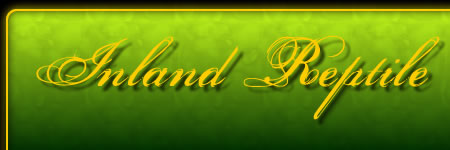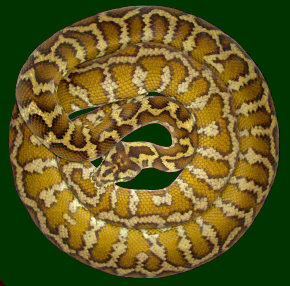

Description
 Though all populations on New Guinea are similar this description pertains only to the Indonesian population, as the others are not represented in captive collections.
Though all populations on New Guinea are similar this description pertains only to the Indonesian population, as the others are not represented in captive collections.
Papuan carpet pythons undergo a dramatic ontogenetic color change. Hatchlings are clad is reddish tones that quickly fade. Juveniles darken and for much of the first year can even resemble juvenile M.cheynei. As they mature the base color lightens and adults are predominantly brown snakes with lighter pattern elements bordered in dark scales. Specimens may be  either banded or striped and there is considerable variation in pattern and color.
either banded or striped and there is considerable variation in pattern and color.
This is considered to be a smaller form of carpet python with adults rarely exceeding 6’ in length. This population tends to mature smaller and reproduce younger on average than other populations of carpet pythons.
The Papuan Carpet Python was designated Morelia s. harrisoni in 2000. This taxonomic designation has not been widely accepted and its validity is in question. We do believe that this form is worthy of taxonomic recognition at either the full species or sub-species level.
Habitat
_thm.jpg) All of the carpet python populations on the island of New Guinea inhabit isolated patches of savannah and open eucalypt forest. Carpet pythons appear to be excluded from the rainforest that surrounds these isolated patches of habitat. These few areas of savannah are very similar to the habitat present in top end Australia. These areas are drier and more open than the surrounding rainforest. Carpet pythons are reported to me more terrestrial in these populations, frequenting mammal borrows.
All of the carpet python populations on the island of New Guinea inhabit isolated patches of savannah and open eucalypt forest. Carpet pythons appear to be excluded from the rainforest that surrounds these isolated patches of habitat. These few areas of savannah are very similar to the habitat present in top end Australia. These areas are drier and more open than the surrounding rainforest. Carpet pythons are reported to me more terrestrial in these populations, frequenting mammal borrows.
Distribution
 This form is endemic to the island of New Guinea. There are at least three disjunct populations on the island on both the Indonesian side as well as in Papua New Guinea. The three known populations on the southern coast are small with each consisting of only a few hundred square miles of Savannah and open forest. The best known is the population centered around Merauke on the Indonesian side of the island. The eastern edge of this population lies along the border with PNG.
This form is endemic to the island of New Guinea. There are at least three disjunct populations on the island on both the Indonesian side as well as in Papua New Guinea. The three known populations on the southern coast are small with each consisting of only a few hundred square miles of Savannah and open forest. The best known is the population centered around Merauke on the Indonesian side of the island. The eastern edge of this population lies along the border with PNG.
About one hundred miles east of the Indonesian population there is another small population of carpet pythons in the Trans-Fly delta.
The last major population occurs in the vicinity of Port Moresby PNG.
There is also a single report from 1920 of a specimen collected along the Memberamo River in north central Papua (Indonesia), approximately 40 miles inland from the coast.
Projects
I am currently working with three bloodlines. I maintain animals from VPI stock as well as animals produced in Europe.
In addition to traditional Papuan carpets I have also recently imported a small group of very atypical specimens from Europe. These animals are from the “Nova Guinea” bloodline and are something of an enigma. This lineage is often purported to have originated from one of the PNG populations of carpet python but there is no firm evidence that this is the case. These carpets are however morphologically distinct from typical Papuan carpets. They exhibit more muted colors and lack the red neonate color of normal Papuan hatchlings. These carpets also have light silver eyes. This form also appears to have a more elongated head structure with a slightly upturned rostral area. Whether these animals hail from a different population or are merely a sub-set of the common Papuan Carpet Python population is not known.
I am currently also working with 1.1 homozygous granite Papuan carpet pythons as well as 1.3 heterozygous granite Papuan carpets. This is an exiting mutation only now being reproduced in the US.
